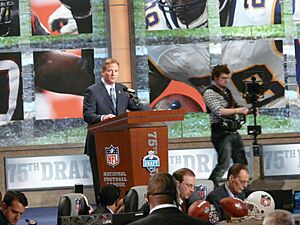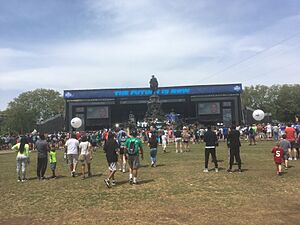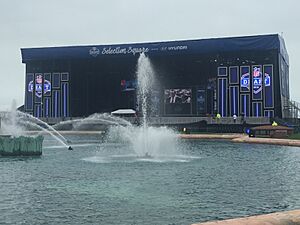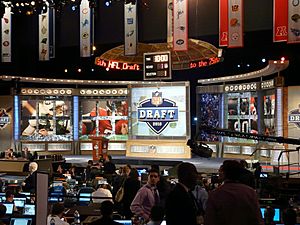NFL draft facts for kids
The NFL draft, also called the Annual Player Selection Meeting, is a yearly event where National Football League (NFL) teams pick new players. It's the main way teams get new talent.
Each team gets a turn to pick a player. The team with the worst record from the year before picks first. The Super Bowl champion picks last. Teams with the same record take turns picking in different rounds. A team can either pick a player or trade its turn to another team for other picks or players. The draft has been held every year since 1936.
The draft has changed over time, but the main idea is still the same. It now has seven rounds. The draft was created to help all teams have a fair chance to win. In the early days, teams picked players based on rumors or newspaper stories. Later, teams started hiring scouts to find the best players.
The draft is named after the NFL season when the players will start playing. For example, the 2010 NFL draft was for the 2010 NFL season. The draft used to be in New York City for 50 years. Now, different cities bid to host it each year because it's become very popular. It's even shown on TV during prime time!
Contents
History of the NFL Draft

In the early 1930s, a college football star named Stan Kostka was so good that every NFL team wanted him. Because there was no draft, Kostka waited for the highest offer. He ended up signing a big contract with the Brooklyn Dodgers. To stop teams from overpaying for players, the NFL started the draft in 1936.
Also, in 1934, Art Rooney, who owned the Pittsburgh Steelers, gave two players to the New York Giants. This was because his team wasn't doing well. Other owners protested, and the NFL made a rule to stop such trades. This rule helped make things fairer.
Bert Bell, co-owner of the Philadelphia Eagles, felt his team couldn't compete. Good players often signed with the richest or most famous teams. Bell couldn't even sign Stan Kostka. So, Bell suggested a draft to help all teams have an equal chance to get good players. This idea was accepted by everyone in 1935, and the first draft happened the next year.
For the first draft, teams made a list of college seniors. Teams then picked players in reverse order of how they finished the year before. The team that picked a player had the only right to sign them. If they couldn't agree on a contract, the player couldn't play for any NFL team that year. The Eagles finished last in 1935, so they got the first pick in the 1936 draft.
The First Draft (1936)
The first NFL draft took place in Philadelphia on February 8, 1936. Ninety player names were written on a blackboard. Teams didn't have scouts, so they used newspaper articles or tips to find players. The draft lasted nine rounds and wasn't covered by the media.
The first player picked was Jay Berwanger. The Eagles couldn't sign him, so they traded him to the Bears. But the Bears also couldn't sign Berwanger. Many players picked in this first draft didn't end up playing in the NFL.
This draft showed how smart Wellington Mara was. He collected information on college players from magazines and newspapers. This helped the Giants pick Tuffy Leemans, who became a great player. Because of the draft, teams could offer lower salaries to new players, which some people thought was unfair to the players.
Early Drafts (1937–1946)
In the 1938 NFL draft, Art Rooney picked Byron "Whizzer" White. White had said he wouldn't play pro football because he was going to study in England. But Rooney offered him a huge contract of $15,000, which was double what other players made. White agreed to play for one season. This big salary upset other owners because it changed what college players expected to be paid.
In the 1939 NFL draft, Wellington Mara was in charge of picking players for the Giants. He surprised everyone by picking a player not on the official list. He joked that he didn't put every name on the list.
In 1939, Kenny Washington was an amazing college player. But because he was African-American, no team drafted him for the 1940 NFL draft.
"Bullet Bill" Dudley was the first player picked overall in the 1942 NFL draft to later join the Pro Football Hall of Fame.
Scouting Begins (1946–1959)
Eddie Kotal became the first full-time player scout in 1946 for the Los Angeles Rams.
For a while, the NFL had a "bonus pick" system to compete with another league. The first pick was chosen randomly, and the last-place team picked second. This system was stopped by 1958.
It took some time for the draft to make all teams equally competitive. Teams like the Eagles and Chicago Cardinals didn't get much better until 1947.
In the 1949 NFL draft, George Taliaferro was the first African-American player picked. He chose to play for another league. Wally Triplett was the first African-American player picked in the draft to actually play for an NFL team. Later, Paul "Tank" Younger became the first NFL player from an historically black college. His coach told him that his success would help other black college players get drafted.
Technology and TV (1960–1979)
The 1960 NFL draft was a big moment because a new league, the American Football League (AFL), was starting. This made the draft much more competitive.
In 1976, former NFL player Paul Salata created the nickname "Mr. Irrelevant" for the very last player picked in the draft.
ESPN and the Digital Age (1980–2017)
In 1980, Chet Simmons, the head of the new TV channel ESPN, asked if they could broadcast the draft live. The NFL agreed, even though they didn't think it would be popular. In 1988, the NFL moved the draft to the weekend, and ESPN's ratings went way up.
In 2006, the NFL Network started showing its own draft coverage, competing with ESPN. ESPN pays the NFL a fee to show the draft.
In 2010, the NFL draft became a three-day event. The first round is on Thursday night, rounds two and three are on Friday night, and the last four rounds are on Saturday.
TV Coverage (2018-Present)
In 2018, the draft was shown on regular TV for the first time by Fox and NFL Network. ESPN also continued its own coverage.
Since 2019, ABC has shown all three days of the draft. For the 2020 NFL draft, which was supposed to be in Las Vegas, it was held online because of the COVID-19 pandemic. NFL Network showed ESPN's coverage, and ABC had its own show.
In 2021, NFL Network went back to its own coverage. ESPN and ABC also had separate shows. The 2022 NFL draft finally went to Las Vegas.
How the Draft Works Now
Players can enter the NFL draft if they have been out of high school for at least three years. Most players come from college football teams in the U.S. or Canada. A few players also come from other football leagues. Even if a player didn't play games during a "redshirt" year in college, that year still counts towards their eligibility.
How Teams Pick Players
The order of picks is based on how well each team did the previous season and if they made the playoffs. Teams that didn't make the playoffs pick first, with the team having the fewest wins picking first overall. If teams have the same record, there are special rules to decide who picks first. For example, the team whose opponents won fewer games gets an earlier pick.
Teams that made the playoffs pick later. The Super Bowl champion picks last (32nd).
| Status | Draft picks |
|---|---|
| Teams not in playoffs | 1–18 |
| Lost in wild card round | 19–24 |
| Lost in divisional round | 25–28 |
| Lost in conference championships | 29–30 |
| Super Bowl runner-up | 31 |
| Super Bowl champion | 32 |
The pick order usually stays the same for all rounds. However, teams with the same record will "cycle" their picks in later rounds. This means they take turns picking first among themselves in different rounds.
Sometimes, when new teams are added to the league, they get the first pick.
Time Limits for Picks
Each team has a limited time to make their pick:
- 10 minutes in the first round
- 7 minutes in the second round
- 5 minutes in rounds three through six
- 4 minutes in the seventh round
If a team doesn't pick in time, the next team can pick. This means the team that was late might lose out on a player they wanted. This happened in the 2003 NFL draft when the Minnesota Vikings were late, and two other teams picked before them.
Trading Picks
Teams can trade draft picks with each other. They can trade picks for the current draft or for future drafts (up to three years ahead). They can trade picks for other picks, for players, or for a mix of both. This means a team might have many picks in one round or no picks at all.
Extra Picks (Compensatory Picks)
The NFL gives out 32 extra picks, called "compensatory picks," to teams. These picks are given to teams that lost more good players in free agency than they signed the year before. These picks are usually in rounds three through seven, at the end of each round. The value of the pick depends on how good the player lost was and how much money they signed for with their new team. These picks can also be traded.
In November 2020, the NFL added a new rule called Resolution JC-2A. This rule gives extra draft picks to teams that help develop minority coaches or general managers who then get hired by other teams. For example, the Los Angeles Rams got picks in 2021 and 2022 because their college scouting director, Brad Holmes, became the general manager for the Detroit Lions. These picks are given at the end of the third round.
Player Salaries
The NFL has rules about how much money teams can spend on their new players from the draft. This amount is part of the team's overall salary cap. Teams with more picks or earlier picks get more money to spend on their rookies.
Players picked higher in the draft get paid more than players picked later. There's a general pay scale for new players. Players who aren't drafted can sign with any team as "rookie free agents," but they usually get paid less.
Before 2011, teams with the first pick could agree to a contract with a player before the draft. For example, in 2009, Matthew Stafford signed a huge deal with the Detroit Lions a day before he was picked first overall. But since 2011, all drafted rookies have their pay and contract length set before the draft.
Losing Draft Picks
The NFL commissioner can take away draft picks from teams that break league rules. Since 1980, 28 picks have been taken away from teams for various rule violations. The New England Patriots have lost the most picks (five for four violations). Reasons for losing picks include trying to get around salary cap rules, illegally filming other teams, or violating rules about talking to players from other teams.
For example, the New Orleans Saints lost picks in 2012 and 2013 for a "bounty" scandal, where players were rewarded for hurting opposing players. The New England Patriots lost picks in 2008 and 2016 for controversies involving videotaping and deflating footballs.
Draft Events and Fun
The draft was first shown on TV by ESPN in 1980. It has become a huge TV event in the U.S. For many years, it was held in New York City. But starting in 2015, the NFL began letting different cities bid to host the draft.
Chicago hosted in 2015 and 2016, and they made the draft a much bigger event. They created a free fan festival called "Draft Town" in a park, which attracted 200,000 visitors. Fans could watch the draft live and enjoy other activities. The NFL has kept this big festival style for drafts in other cities. The 2024 NFL draft in Detroit had over 775,000 visitors, setting a new record!
Things That Happen Before the Draft
NFL Draft Advisory Board
College players who are thinking about entering the NFL draft but could still play in college can ask the NFL's Draft Advisory Board for advice. This group of experts predicts which round a player might be drafted in. This helps players decide if they should enter the draft or stay in college to improve.
NFL Scouting Combine
The NFL Scouting Combine is a six-day event held every year in late February or early March in Indianapolis. College football players do physical and mental tests in front of NFL coaches, general managers, and scouts. This event has become very important, allowing teams to compare players in the same way. Players are invited to attend. How well a player does at the Combine can greatly affect where they are picked in the draft and how much money they earn. Sometimes, a player who performs amazingly at the Combine but had an average college career is called a "Workout Warrior."
Pro Day
Each university has a "Pro Day." This is when NFL scouts visit the school to watch players do drills similar to those at the Combine. Smaller schools sometimes team up for a joint Pro Day. These events are like job fairs for college players hoping to join the NFL.
Pre-Draft Visits
Each NFL team can invite up to 30 draft-eligible players to visit their facilities. During these visits, players get physical exams, interviews, and written tests. If a player lives near the team, that visit doesn't count toward the 30-player limit.
All-Star Games
Before the draft, college football players can play in special all-star games. These games let players show off their skills to NFL scouts. Starting in 2024, even college juniors can play in some of these games, like the Senior Bowl, East-West Shrine Bowl, and HBCU Legacy Bowl.
Senior Bowl
The Senior Bowl happens a few weeks after the college football championship in Mobile, Alabama. It's a chance for college players to show their skills to NFL scouts. Many successful NFL players, like Von Miller and Patrick Mahomes, played in the Senior Bowl.
East-West Shrine Bowl
Started in 1925, the East-West Shrine Bowl is the oldest college all-star game. College players who plan to enter the NFL draft play in this game. It helps coaches and players show their abilities and learn from NFL coaches. It also raises money for Shriners Hospitals for Children. Famous players like Tom Brady and John Elway played in this game.
HBCU Legacy Bowl
Started in 2022, this game is for players from historically black colleges and universities (HBCU) who are eligible for the NFL draft. It's played in New Orleans, Louisiana, and is usually the last all-star game before the draft. It also hosts the NFL's HBCU Combine.
Hula Bowl
This is a college football all-star game held yearly in Hawaii, usually in January. Players show off their skills for NFL scouts. Famous players like Mike Ditka and Dan Marino played in the Hula Bowl.
Tropical Bowl
Held in Florida since 2016, this game has had over 350 alumni go on to play in the NFL.
College Gridiron Showcase
This event, held in Texas since 2015, is for players from smaller colleges. It helps these players get noticed by NFL teams and other professional leagues. It includes drills and practice games, and also teaches players about the business side of a pro football career.
Tickets to the Draft
Tickets to the NFL draft are free! Fans can get them on a first-come, first-served basis on the morning of the draft.
Where the Draft Has Been Held
From the mid-1930s to the mid-1960s, the draft was held in different cities where NFL teams were located.
Between 1965 and 2014, the NFL draft was always held in New York City. It was held at places like the Theater at Madison Square Garden and Radio City Music Hall.
Since 2015, the league has opened up the draft location to a bidding process. Chicago hosted in 2015 and 2016, which started the trend of the draft being a big event with lots of fans. After Chicago, the NFL has held the draft in a different city each year.
The 2020 NFL draft was supposed to be in Las Vegas, but it was held online because of the COVID-19 pandemic.
Future Draft Locations
- Pittsburgh, 2026
- Washington, D.C., 2027
Summary of Host Cities
- Chicago: 9 times (1938, 1942–1943, 1951, 1962–1964, 2015–2016)
- Cleveland: 1 time (2021)
- Dallas: 1 time (2018)
- Detroit: 1 time (2024)
- Green Bay: 1 time (2025)
- Kansas City: 1 time (2023)
- Las Vegas: 1 time (2022)
- Los Angeles: 1 time (1956)
- Milwaukee: 1 time (1940)
- Nashville: 1 time (2019)
- New York City: 57 times (1937, 1939, 1945–1947, 1952, 1955, 1965–2014)

- Philadelphia: 15 times (1936, 1944, 1949–1961, 2017)
- Pittsburgh: 2 times (1948–1949)
- Washington, D.C.: 1 time (1941)
Supplemental Draft
Since 1977, the NFL has also held a "supplemental draft." This is for players who missed the deadline for the main draft or had problems with their college eligibility. It happens after the main draft but before the new season starts.
In the supplemental draft, teams don't have to use a pick. If a team wants a player, they tell the Commissioner which round they would pick that player in. If no other team wants the player earlier, that team gets the player. But then, they have to give up their pick in the same round in the next year's draft. For example, if a team picks a player in the fourth round of the supplemental draft, they lose their fourth-round pick in the next year's regular draft.
The 1985 supplemental draft was very famous because of quarterback Bernie Kosar. He wanted to play for the Cleveland Browns. His agent found a way for him to enter the supplemental draft instead of the regular draft, so the Browns could pick him. This caused a lot of arguments between teams, but no rules were broken. After this, the NFL changed the rules for the supplemental draft order.
Later, other top players used this strategy if they didn't want to play for the team that would have drafted them in the regular draft. For example, in 1987, Brian Bosworth didn't enter the main draft because he didn't want to play for certain teams. The Seattle Seahawks then picked him in the supplemental draft and signed him to a very large contract.
Since 1993, the supplemental draft has mostly been for players who planned to go to college but couldn't for various reasons.
See also
 In Spanish: Draft de la NFL para niños
In Spanish: Draft de la NFL para niños
- Draftnik
- List of professional American football drafts
- List of NFL draft broadcasters
- List of first overall NFL draft picks
- List of second overall NFL draft picks
- Mr. Irrelevant



